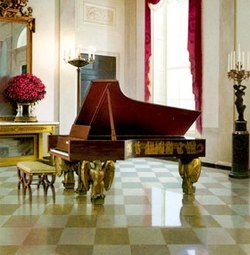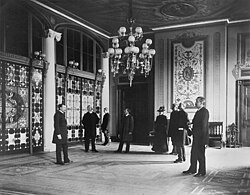Entrance Hall
This article needs additional citations for verification. (December 2016) |






The Entrance Hall (also called the Grand Foyer) is the primary and formal entrance to the
Hoban's 1792 and 1817 designs
Architect
With the north entrance to the White House used frequently in this period, it was not uncommon for cold air to push into the Entrance Hall and then pass through the spaciously separated columns into the Cross Hall beyond. To remedy the draft problem, President Martin Van Buren had floor-to-ceiling glass partitions installed between the Hoban columns.[2]
Changes by Walter and Brumidi
In 1853
Tiffany and the Aesthetic Movement
In 1882 President
McKim's return to Neoclassicism
In 1902, soon after taking office and occupying the White House, President
In the Entrance Hall, McKim removed the Tiffany screen,
Truman reconstruction
By 1948 the White House had become physically unstable, and the house was temporarily vacated while a major reconstruction took place. The building's interior was dismantled, the furnishings and decorative items were stored, and a new steel frame was built within the exterior walls. Truman used this opportunity to reposition the entrance to the Grand Stair. Architect Lorenzo Simmons Winslow explored several options for the reorientation of the Grand Stair before convincing President Truman of the present configuration where it opens to the center of the east wall of the Entrance Hall.[10] Except for the new stair opening, most of McKim's design was followed but now reinterpreted in light gray Joliet marble instead of warm hued Sienna stone and painted plaster. Cut into the stone casement around the opening to the Grand Staircase are the seals of the thirteen original American states.[11] The Truman era floor is laid in a tessellated pattern of Westbury cream and Vermont marble. Truman thought it inappropriate to walk across the seal of the president that McKim had placed in the floor,[12] and had the bronze seal moved to the ground floor above the entrance to the Diplomatic Reception Room. In place of the bronze seal in the floor, Truman had a polychrome painted plaster seal installed above the entrance to the Blue Room.
Kennedy restoration
During the John F. Kennedy administration, the Entrance Hall (like most of the White House) underwent an extensive historic redecoration. The redecoration of the State Floor rooms, including the Entrance Hall, was overseen by American antiques
Use over time
When the White House interiors were first completed during the administration of John Adams the house was primarily entered from a temporary wooden piazza on the south. President Thomas Jefferson used the Entrance Hall as a "Cabinet of Natural History" displaying finds from the Lewis and Clark Expedition.
In the 20th century the Entrance Hall has been used for official welcomes, receiving lines, small concerts, and dancing. Actor John Travolta danced with Diana, Princess of Wales in 1985; in 1998 First Lady Hillary Clinton danced here with Czech President Václav Havel.
Furnishings
On the west wall of the room is a
In the southeast and southwest corners of the Entrance Hall are crimson and gold upholstered French Empire banquettes acquired by interior designer Stéphane Boudin of Maison Jansen during the John F. Kennedy administration. The McKim era bronze torchères remain in the room. A pair of Louis XVI torchères flank the door leading to the North Portico. A pair of armchairs commissioned for the Blue Room in 1902 and based on a suite of chairs designed by Jacob-Desmalter in the Salon des Fleurs of the Château de Compiègne are placed on the North wall.
References
- Notes
- ^ It has long been known that McKim, Mead & White sold the Tiffany screen at auction for $275 ($9,684 in 2023 dollars), less than a tenth of its original value.[6] But the purchaser was not known. However, in June 2005, Harriet Stout, curator of the Chesapeake Beach Railway Museum in Chesapeake Beach, Maryland, told the producers of the PBS series Antiques Roadshow that the Chesapeake Beach Railway purchased the glass screen and had it installed at the Belvedere Hotel in Chesaspeake Beach. Unfortunately, the hotel burned in 1923, and the screen was lost.[7] Former First Daughter Margaret Truman also claimed that the screen ended up at the Belvedere Hotel in Chesapeake Beach, only to be lost to fire.[8]
- Citations
- ^ Seale 1992, pp. 8–9.
- ^ Filler, Martin (March 2009). "Red, White, and Tiffany Blue". Antiques: The Magazine. Archived from the original on July 12, 2015. Retrieved June 3, 2015.
- ^ Seale 1992, pp. 135, 142–143.
- ^ Scott 1995, pp. 102–103.
- ^ Kloss 1992, pp. 162–165.
- ^ Beschloss 2008, p. 138.
- ^ "Missing Masterpieces". Antiques Roadshow FYI. PBS. June 22, 2005. Retrieved June 3, 2015.
- ^ Truman 2003, p. 34.
- ^ Seale 1992, pp. 186–187.
- ^ Seale 1992, pp. 242–245.
- ^ Commission on the Renovation of the Executive Mansion 1952, p. 73.
- ^ Wolff & Kennedy 1962, p. 89: "President Truman thought it inappropriate for the President's Seal to be placed on the floor of the hall, where visitors would walk across it."
- ^ Abbott & Rice 1998, p. 56.
- ^ Abbott & Rice 1998, pp. 36–37.
Bibliography
- Abbott, James A.; Rice, Elaine M. (1998). Designing Camelot: The Kennedy White House Restoration. New York: Van Nostrand Reinhold. ISBN 0442025327.
- Beschloss, Michael (2008). Presidential Courage: Brave Leaders and How They Changed America, 1789-1989. New York: Simon and Schuster. ISBN 9780743257442.
- Commission on the Renovation of the Executive Mansion (1952). Report of the Commission on the Renovation of the Executive Mansion. Washington, D.C.: U.S. Government Printing Office. .
- Kloss, William (1992). Art in the White House: A Nation's Pride. Washington, D.C.: White House Historical Association. ISBN 9781931917018.
- Scott, Pamela (1995). Temple of Liberty: Building the Capitol for a New Nation. New York: Oxford University Press. ISBN 0195098587.
- Seale, William (1992). The White House: The History of an American Idea. Washington, D.C.: American Institute of Architects Press. ISBN 0912308850.
- Truman, Margaret (2003). The President's House: A First Daughter Shares the History and Secrets of the World's Most Famous Home. New York: Ballantine Books. ISBN 9780345444523.
- Wolff, Perry; Kennedy, Jacqueline (1962). A Tour of the White House with Mrs. John F. Kennedy. New York: Doubleday.
Further reading
- Abbott, James A. A Frenchman in Camelot: The Decoration of the Kennedy White House by Stéphane Boudin. Boscobel Restoration Inc.: 1995. ISBN 0-9646659-0-5.
- Abbott, James A. Jansen. Acanthus Press: 2006. ISBN 0-926494-33-3.
- Abbott, James Archer. Jansen Furniture. Acanathus Press: 2007. ISBN 978-0-926494-45-9.
- Clinton, Hillary Rodham. An Invitation to the White House: At Home with History. Simon & Schuster: 2000. ISBN 0-684-85799-5.
- Leish, Kenneth. The White House. Newsweek Book Division: 1972. ISBN 0-88225-020-5.
- Monkman, Betty C. The White House: The Historic Furnishing & First Families. Abbeville Press: 2000. ISBN 0-7892-0624-2.
- Seale, William. The President's House. White House Historical Association and the National Geographic Society: 1986. ISBN 0-912308-28-1.
- West, J.B. with Mary Lynn Kotz. Upstairs at the White House: My Life with the First Ladies. Coward, McCann & Geoghegan: 1973. ISBN 978-069-8-10546-1.
- The White House: An Historic Guide. White House Historical Association and the National Geographic Society: 2001. ISBN 0-912308-79-6.
External links
- White House website for the Entrance and Cross Hall
- White House Museum's Entrance Hall page, with many additional historical pictures
